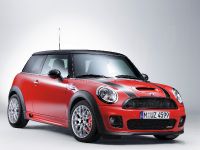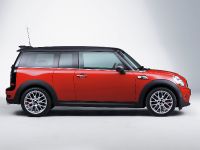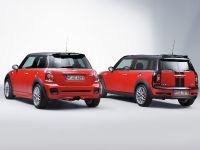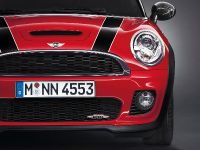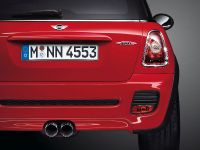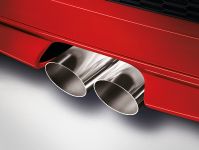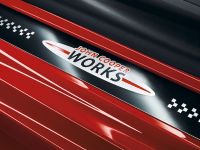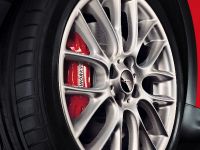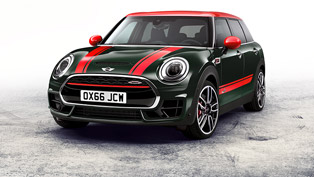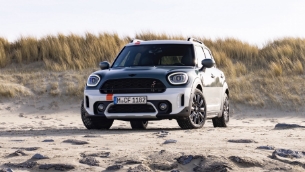The MINI John Cooper Works Clubman
New addition to the MINI family focusing in particular on sporting performance – and at the same time establishing a new market position for John Cooper Works. The MINI John Cooper Works and the MINI John Cooper Works Clubman provide the driving pleasure so typical of MINI in true racing character reflecting the unique nature and tradition of John Cooper Works.
• Drivetrain and chassis components derived directly from the MINI John Cooper Works CHALLENGE racing model: 155 kW/211 hp four-cylinder with twin-scroll turbocharger and direct gasoline injection, extra-light 17-inch light-alloy rims, extremely powerful brakes, model-specific exhaust system, modified six-speed manual gearbox.
• Newly developed four-cylinder power unit based on the MINI Cooper S, pistons, valves, turbochargers, intake and exhaust system optimised for motorsport, further increase in power and torque, specific output
132 hp per litre, engine fulfils all requirements of the future EU 5 emission standard.
• Power transmitted to front wheels, sports suspension set-up specifically for each model, front axle with McPherson spring struts, central-arm rear axle with aluminium longitudinal arms, model-specific suspension set-up, sports suspension or, respectively, John Cooper Works suspension with lower
ride height available as an option, electromechanical power steering (EPS), sports button varying the gas pedal control map and steering response available as an option.
• DSC Dynamic Stability Control available as an option including DTC Dynamic Traction Control unique to the MINI John Cooper Works and the MINI John Cooper Works Clubman in the front-wheel-drive market, Brake Assistant and Uphill Set-Off Assistant, sports braking system with anti-lock brakes, Electronic Brake Force Distribution (EBFD) and electronic Cornering Brake Control (CBC), sporting, ambitious style of motoring enhanced by individual intervention of the brakes through electronic Differential Lock Control in the Dynamic Stability Control off-mode.
• Crash-optimised passenger cell; six airbags featured as standard; three-point inertia-reel seat belts on all seats; belt latch tensioners and belt force limiter at the front; belt warner; ISOFIX child seat fastening system at the rear featured as standard.
• Sporting, purist and sophisticated interior, three-spoke sports steering wheel in leather featured as standard, roof lining in Anthracite, interior surfaces in Piano Black, model-specific speedometer.
• Wide range of customisation options outside and inside in typical MINI style; wide range of interior colours, trim and upholstery; wide range of John Cooper Works performance components highlighting the active driving character of the MINI John Cooper Works and the MINI John Cooper Works Clubman; model-specific range of options and accessories; top-end audio and navigation systems as well as mobile communication interfaces including the option to completely integrate an Apple iPhone and other Smartphones for parallel use of communication and entertainment functions.
• Combination of race-proven, ultra-strong and rugged technology with the reliability and everyday driving qualities typical of MINI to give the John Cooper Works models under the MINI brand their unique character of performance and premium class. Exclusive standard of quality as on the other MINI models, also comprising John Cooper Works accessories developed as an option especially for the MINI. Integrated production of the MINI John Cooper Works and MINI John Cooper Works Clubman at the MINI Plant in Oxford according to the high standards of the BMW Group.
• Parallel launch of both models: MINI John Cooper Works with its long tradition in motorsport full of outstanding success, four-seater in classic body configuration with two doors and tailgate opening up to a high angle. MINI John Cooper Works Clubman as an ultra-modern car concept combining superior sportiness with innovative body design, comfort and practicability through the Clubdoor on the right-hand side and the Splitdoor at the rear, additional legroom at the rear, either five- or four-seater.
• Model variants:
MINI John Cooper Works: four-cylinder gasoline engine with twin-scroll turbocharger and direct fuel injection, engine displacement 1598 cc, output 155 kW/211 hp at 6,000 rpm, max torque 260 Nm/192 lb-ft from 1,850–5,600 rpm (280 Nm/206 lb-ft from 2,000–5,300 rpm with Overboost), acceleration 0–100 km/h in 6.5 sec, top speed 238 km/h/ 148 mph, average fuel consumption to EU standard 6.9 litres/100 km (40.9 mpg imp), CO2 emissions 165 g/km.
MINI John Cooper Works Clubman: four-cylinder gasoline engine with twin-scroll turbocharger and direct fuel injection, engine displacement 1,598 cc, output 155 kW/211 hp at 6,000 rpm, max torque 260 Nm/ 192 lb-ft from 1,850–5,600 rpm (280 Nm/206 lb-ft from 2,000–5,300 rpm with Overboost), acceleration 0–100 km/h in 6.8 sec, top speed 238 km/h/ 148 mph, average fuel consumption to EU standard 7.0 litres/100 km (40.3 mpg imp), CO2 emissions 167 g/km.
From Driving Pleasure to Sheer Passion:
The sporting talent comes in its DNA, the joy of above-average performance is unparalleled every mile, every kilometre on the road. MINI at its best – ready to go for new records in its strongest discipline: the joy of motoring.
The new MINI John Cooper Works now appearing on the road for the first time following its world debut at the 2008 Geneva Motor Show is an extreme athlete and stands out clearly from the competition in the entire market. It is a unique and unparalleled character just like the MINI One, MINI Cooper, MINI Cooper S, and MINI Cooper D. The MINI John Cooper Works highlights its special position in the small car segment through truly impressive facts and figures: Maximum output of the newly developed four-cylinder power unit complete with its twin-scroll turbocharger and direct gasoline injection is 155 kW/211 hp, peak torque is 260 Newton-metres/192 lb-ft, increasing briefly in Overboost to an even more impressive 280 Newton-metres/206 lb-ft.
The MINI John Cooper Works Clubman is entering the market at the same time with the same performance data and sporting potential, a new top athlete moving up to pole position also in this case, just a few months after the market launch of the new model variant.
This kind of power from the 1.6-litre gives both model variants truly outstanding performance on the road: The MINI John Cooper Works accelerates to 100 km/h in just 6.5 seconds, the MINI John Cooper Works Clubman completes the same exercise a mere 0.3 seconds later. Top speed in both cases is 238 km/h or 148 mph.
The two models are likewise almost equal when it comes to efficiency, the MINI John Cooper Works returning average fuel consumption in the EU test cycle of 6.9 litres/100 kilometres (equal to 40.9 mpg imp), the MINI John Cooper Works Clubman offering an equally impressive 7.0 litres (40.3 mpg imp). The cars' CO2 ratings, in turn, are 165 and, respectively, 167 grams per kilometre.
Joining the model family – and the MINI brand.
Both the MINI John Cooper Works and the MINI John Cooper Works Clubman are regular production models in the MINI range built at MINI Plant Oxford together with other model variants. The introduction of these new top athletes completes the full integration of John Cooper Works, the epitome of extremely dynamic cars, components and accessories full of tradition into the MINI brand.
From motorsport straight to the road – the ideal way to top performance.
Like the MINI John Cooper Works Clubman, the MINI John Cooper Works is a genuine MINI in every respect. And what a MINI! The drivetrain comes straight from motorsport, the exclusive light-alloy, extra-light wheels, the extremely powerful brakes, the new exhaust system and the modified six-speed manual gearbox also stem from the new MINI John Cooper Works CHALLENGE race car. Rarely does the know-how gained in motorsport take such an immediate and direct path to the road.
This obviously also ensures a particularly high standard of all-round quality, both new models being required to meet the extreme demands and challenges of the race track in every respect and to fulfil all the needs of everyday motoring in terms of function, design, reliability, and a long running life. As a result, both the MINI brand and John Cooper Works represent a powerful commitment to quality quite unique within the MINI's market segment.
Built and conceived for supreme driving pleasure: chassis, brakes, assistance systems.
Not only a particularly powerful engine, but also a wide range of other components conveying the supreme power of the engine smoothly and safely to the road come as standard on both the MINI John Cooper Works and the MINI John Cooper Works Clubman. Apart from the 17-inch light-alloy rims also derived from the MINI John Cooper Works CHALLENGE racing model as well as equally large and extra-powerful disc brakes on all four wheels, DSC Dynamic Stability Control including DTC Dynamic Traction Control naturally come as standard. This combination, just like the electronic differential lock on the front axle likewise featured as standard, is quite unique in this segment. And in future both systems will also be available as optional extras on the MINI Cooper S.
Following MINI's usual philosophy, engine power is conveyed straight to the front wheels. The six-speed manual gearbox tailored directly to the characteristics of the high-performance engine ensures a smooth gearshift at all times even in dynamic driving manoeuvres.
The Sports Button also featured as standard is positioned directly next to the John Cooper Works gearshift lever on the centre console. Simply by pressing this button, the driver activates a special gas pedal control map conceived for even more dynamic performance and an even more direct response from the steering. A leather sports steering wheel, the roof lining finished in Anthracite, interior trim in Piano Black, as well the Center Speedo extending all the way to 260 km/h or 160 mph round off the interior of the MINI John Cooper Works and the MINI John Cooper Works Clubman conceived and designed from the start for purist sportiness and style.
The drivetrain: motorsport technology for all the challenges in everyday motoring.
MINI, John Cooper Works and motorsport belong together – that was already the case 50 years ago and is still the case today. And this comes out most clearly when looking into the engine compartment of the MINI John Cooper Works and the MINI John Cooper Works Clubman, admiring an outstanding power pack based on the current engine featured
in the MINI Cooper S, thoroughly upgraded for the MINI racing model in the John Cooper Works CHALLENGE, and now returning to the road with fresh power and muscle in the MINI John Cooper Works.
With cylinder bore (77 millimetres/3.03") and stroke (85.8 millimetres/3.38") remaining the same, both overall engine displacement of 1,598 cubic centimetres and the distance between cylinders of 84 millimetres/3.31" are also the same as before. Over and above these regular features, however,
the four-cylinder engine block boasts a number of technical highlights carried over directly from motorsport. Both the cylinder block and the bearing housing, for example, are made of cast aluminium, while integration of the chain box in the bearing housing saves weight and improves noise control.
The four valves per cylinder are driven by two overhead camshafts, friction-optimised roller-type drag arms, and hydraulic valve play equalisers. The exhaust valves are filled with sodium to fulfil the greater cooling requirements in a turbocharged engine. The intake camshaft comes with infinite phase adjustment varying valve timing according to current power and performance requirements.
The camshafts in the four-cylinder MINI are composite units with the cam rings made of high-strength stainless steel shrunk-fit on to the camshaft as such, contrary to the conventional casting procedure.
Subsequently the cams are fine-polished down to an accuracy of 1?1000 th millimetre.
With consistent lightweight technology contributing to the car's agility both on the race track and the road, the focus has been on minimising the weight of the car wherever possible. The crankshafts, for example, are also built for minimum weight and come with special bearing cells and relatively small bearing journals measuring 45 millimetres or 17.7" in diameter. The alternator and a/c compressor, in turn, are driven by one single poly-V belt, while the coolant pump is driven by a friction gear.
All together, these features and construction concepts make the drive unit particularly compact, the new four-cylinder therefore being not only the most powerful, but also one of the shortest engines of its kind in this category.
The power units for the MINI John Cooper Works and the MINI John Cooper Works Clubman are made at the BMW Group's Hams Hall Engine Plant in Great Britain, which assembles the engines for all versions of the MINI. The top engine naturally benefits from various improvements in the production process in the interest of enhanced performance, taking the higher temperatures in the combustion chambers into account and thus guaranteeing maximum reliability.
The power units featured in the MINI John Cooper Works and the MINI John Cooper Works Clubman also come with reinforced, specially polished pistons as well as a cylinder head optimised for strength and stability and with a modified cylinder gasket. The intake valves and valve seat rings =are also made of a particularly strong and resistant material, yet a further modification versus the power unit in the MINI Cooper S being the slight reduction of the engine's compression ratio.
More air, more power, more torque – the formula for more driving pleasure.
Featuring these modifications, the power unit of the MINI John Cooper Works and the MINI John Cooper Works Clubman is built and designed to meet the high quality standards of the MINI brand and John Cooper Works right from the start in every respect. Indeed, it clearly bears out its potential on the very first lap, just as it proves its qualities in everyday motoring under the most gruelling conditions.
The increase in power and performance over the engine featured in the MINI Cooper S comes in particular from the optimised supply and extraction of air as well as modification of the turbocharger. The air filter, air mass meter, exhaust system and catalyst have all been modified for an absolutely smooth flow of air in the intake and exhaust manifolds also contributing to the special sound of the engine: Particularly within the passenger compartment, the John Cooper Works and John Cooper Works Clubman offer an intense experience in sound clearly referring to the supreme sporting potential of the power unit.
The special exhaust system on the two new models is recognisable at very first sight through the polished stainless steel twin tailpipes each measring 85 millimetres or 3.35" in diameter. Modification of the exhaust system also helps to significantly reduce counter-pressure and it almost goes without saying that both the MINI John Cooper Works and the MINI John Cooper Works Clubman fulfil all the requirements of the particularly strict EU 5 and ULEV II emission standards in Europe and, respectively, the USA.
The clean air pipe leading to the turbocharger has also been enlarged in capacity, the new top-of-the-range engine featuring a twin-scroll turbocharger like the power unit in the MINI Cooper S. Through its concept and operating principle, this special turbocharger ensures particularly spontaneous build-up of power, with the ducts in the exhaust gas manifold and turbocharger separated from one another for two cylinders at a time. This helps to reduce exhaust gas counter-pressure at low engine speeds, capitalising on the dynamic effect of the pulsating gas columns in the manifold.
This special effect enhances the response of the turbocharger with its turbocharger blades reacting immediately and rotating at exactly the right speed even at low engine revs. The turbine is made of particularly sophisticated, top-quality material specifically for the power unit of the MINI John Cooper Works and the MINI John Cooper Works Clubman, with maximum charge pressure increased from 0.9 to 1.3 bar in order to maintain the highest possible temperature for a longer period in the combustion chambers.
This extension of the combustion process helps to significantly enhance the torque curve of the new four-cylinder, with maximum torque of 260 Newton-metres or 192 lb-ft at just 1,850 rpm. When accelerating, torque is briefly increased to 280 Newton-metres or 206 lb-ft by extra turbocharger boost in the speed range between 1,950 and 5,500 rpm, this Overboost function giving the MINI John Cooper Works and the MINI John Cooper Works Clubman even more powerful and dynamic acceleration. An important point is that this function acts exclusively on engine torque and not on engine output.
Direct gasoline injection: precise dosage and efficient use of fuel.
With its specific output of 132 hp per litre, the power unit featured in the MINI John Cooper Works and the MINI John Cooper Works Clubman enters the exclusive terrain of the most thoroughbred and dynamic sports cars. In its character, the new top-of-the-range engine offers thrilling elasticity and harmonious power and thrust, reaching its maximum output of 155 kW/211 hp at 6,000 rpm.
The direct and immediate response of the engine also ensures outstanding acceleration with the MINI John Cooper Works reaching 100 km/h in just 6.5 seconds, the MINI John Cooper Works Clubman in 6.8 seconds.
Top speed of both models is 238 km/h or 148 mph.
Over and above their outstanding performance, the two new models also come with the typical ability of a MINI to combine unique driving pleasure with outstanding efficiency. So taking their outstanding performance into account, both the MINI John Cooper Works and the MINI John Cooper Works Clubman are extremely modest in their consumption of fuel. The fuel supply system is the key factor in this context, the turbocharged four-cylinder featuring direct gasoline injection using the common-rail principle. In this case the common rail made of stainless steel is filled by a high-pressure pump at the rear end of the intake camshaft, fuel thus flowing into the rail under high pressure.
Injection valves positioned on the side of the cylinder head then deliver the fuel within fractions of a second and in a precise dosage at 120 bar from the common rail directly to the combustion chambers, ensuring optimum supply of fuel tailored precisely to engine load and operating conditions at all times and in all situations.
Average fuel consumption in the EU test cycle, benefiting from this technology, is unusually low for a car of this calibre: The MINI John Cooper Works requires just 6.9 litres/100 kilometres (equal to 40.9 mpg imp), the MINI John Cooper Works Clubman makes do with 7.0 litres (40.3 mpg imp). The corresponding CO2 ratings, in turn, are 165 and, respectively, 167 grams per kilometre.
Go-kart feeling in a new dimension.
Highly effective muscle training on the engine is the fundamental, but not the only feature that turns the MINI John Cooper Works and the MINI John Cooper Works Clubman into truly outstanding performers. For to convert extra power into a supreme driving experience, the specialists working on the car have carefully analysed which features had to be modified according to the new requirements. This ensured efficient development of the new models according to a precise overall concept appropriately reflecting the premium character of the MINI brand and John Cooper Works.
Engine power is conveyed to the front wheels in typical MINI style. Both the MINI John Cooper Works and the MINI John Cooper Works Clubman come with a six-speed manual gearbox tailored in every respect to the particularly powerful torque of the MINI's top-of-the-range engine. The gear ratios ensure an ideal transition of speed from one gear to the next, thus guaranteeing smooth, consistent and ongoing acceleration without the slightest interruption. And the John Cooper Works gearshift lever featured as standard enhances the joy of shifting gears quickly and dynamically.
The go-kart feeling so characteristic of all models in the MINI range results primarily from the car's low centre of gravity and demanding suspension technology. The front axle with McPherson spring struts and the central arm rear axle quite unique in the small car segment guarantee perfect grip
on the road beneath also in very dynamic situations and at high speeds.
A further guarantee for the cars' safe and ultra-precise handling is EPS Electrical Power Assisted Steering providing a unique combination of motoring comfort and driving dynamics. Power assistance is varied as a function of speed, allowing the driver to manoeuvre and park the car with minimum effort. Then, with speed increasing, steering forces become greater in the interest of enhanced safety and precision.
A further advantage of electromechanical steering over conventional systems is much lower weight as well as the on-demand operating function serving to save energy: The electrical servo motor is activated only when steering assistance is required or desired by the driver.
Electromechanical steering is able to offer various set-ups programmed in advance. In its basic setting, the steering maintains a well-balanced degree of support as a function of road speed. Then, pressing the Sports Button featured as standard on the centre console next to the gearshift lever in the MINI John Cooper Works and the MINI John Cooper Works Clubman,
the driver can adjust the steering to a far more dynamic response with higher steering forces and enhanced steering precision. At the same time activation of the Sports Button also triggers a particularly sporting and dynamic gas pedal control map.
Suspension, brakes and wheels like on the racing model.
Both the MINI John Cooper Works and the MINI John Cooper Works Clubman come as standard with special sports suspension which also gives the corresponding model variants of the MINI Cooper S their fascinating handling qualities. As an alternative, the new models are also available with a sports suspension featuring even firmer dampers and stronger anti-roll bars both front and rear. And for a very strong focus on motorsport, the MINI John Cooper Works may be fitted with the John Cooper Works suspension as a special accessory lowering the entire car by 10 millimetres, making the dampers and anti-roll bars even firmer, and thus ensuring extra stability through the diameter of the anti-roll bars even thicker than on the sports suspension.
The dynamic qualities of the MINI John Cooper Works and the MINI John Cooper Works Clubman come out clearly not only when accelerating and quickly changing direction, but also when applying the brakes. The sports brakes featured as standard guarantee short stopping distances and combine precise response with fine application of the brakes. The fixed-calliper disc brakes with their aluminium callipers finished in red – complete with inner-venting on the front wheels and clearly distinguished by the John Cooper Works logo on the callipers – are extra-large in their dimensions, designed and built in accordance with the brake systems in the MINI John Cooper Works CHALLENGE race car.
The same applies to the exclusive 17-inch light-alloy wheels in John Cooper Works Cross-Spoke CHALLENGE design also featured as standard: Weighing less than 10 kilos, these are the lightest production wheels in the entire market segment of the MINI John Cooper Works and MINI John Cooper Works Clubman. They differ from the wheels of the same size on the MINI John Cooper Works CHALLENGE only through their rim width adjusted to road traffic requirements and a special fastening system. Eighteen-inch light-alloy rims are also available as accessories.
The 205/45 W 17 high-speed tyres come with failsafe running qualities enabling the driver to continue even after a complete loss of air pressure in order to reach the nearest workshop safe and sound. Yet a further point is that the MINI John Cooper Works and the MINI John Cooper Works Clubman come with a Tyre Defect Indicator permanently monitoring air pressure and informing the driver by a signal in the cockpit display in the event of an emergency.
Featured as standard but quite unique on a front-wheel-drive car: DSC including DTC.
Apart from the sports suspension and powerful brakes, both the MINI John Cooper Works and the MINI John Cooper Works Clubman come with sophisticated driving stability systems. Functions featured as standard include ABS brakes, EBD Electronic Brake Force Distribution, CBC Cornering Brake Control, as well as DSC Dynamic Stability Control including hill start-off assistance and DTC Dynamic Traction Control.
Applying the brakes individually on specific wheels and reducing engine
output where appropriate, DSC is able to stabilise the MINI, preventing the car from swerving out of control over its front or rear wheels in a particularly dynamic situation and on slippery ground.
The Brake Assistant also included in DSC Dynamic Stability Control recognises application of the brakes in an emergency and immediately maximises brake pressure whenever required, again helping to keep stopping distances as short as possible.
As a sub-function of DSC, DTC offers the opportunity for the first time on a front-wheel-drive car to raise the response thresholds of the driving stability control system, intentionally allowing controlled slip on the drive wheels.
Activating the DTC mode at the touch of a button, the driver of the MINI John Cooper Works and the MINI John Cooper Works Clubman is able, for example on a snowbound surface or on loose snow, to pick up speed in a controlled process with the front wheels slightly spinning or to drive the car even closer
to its physical limits in a particularly dynamic situation. Then, when reaching the utmost limit, DSC will intervene as usual also in the DTC mode. If he wishes, however, the driver still has the option to deactivate the DSC function altogether.
Perfect traction through the electronic locking function on the differential.
In the DSC-off mode yet a further function ensures optimum drive power and perfect traction even in particularly fast and dynamic bends: Both the MINI John Cooper Works and the MINI John Cooper Works Clubman are equipped with an electronically controlled locking function for the rear axle differential. Referred to as Electronic Differential Lock Control, this system supports a particularly sporting and ambitious style of motoring, for example when accelerating out of a bend or hairpin. The electronically controlled locking function serves to apply the brakes appropriately on a drive wheel spinning
in a tight bend, promoting the car's traction and pulling force without a negative influence on the car's steering behaviour. As a result, the process of taking a bend becomes even more harmonious and faster.
Interior built like a sports car.
Within the passenger compartment the wide range of regular features ensure a high standard of sporting but sober elegance. A three-spoke sports steering wheel in leather, to mention the first example, forms the interface between the driver and his – or her – sports machine, the roof lining in Anthracite as well as the interior surfaces in glossy Piano Black maintaining a calm atmosphere helping the driver to concentrate on the essential. A further feature of the two top performers is the speedometer extending all the way to 260 km/h or 160 mph.
For athletes with personal style: a unique range of customisation.
The wide range of equipment and accessories available for the new MINI John Cooper Works and the new MINI John Cooper Works Clubman stands out through top quality, design inspired by motorsport, and supreme safety standards. In determining the configuration of the two new outstanding performers, MINI once again offers incomparable freedom of choice through the various features available. The wide range of paintwork colours, interior trim options, seat upholstery, interior colours and trim variants, as well as the comfort features, comes with the same diversity as on the other models. And the equally wide range of special equipment offered by both MINI and John Cooper Works allows further enhancement in terms of comfort, practical qualities, and sporting flair.
The MINI John Cooper Works and the MINI John Cooper Works Clubman are both available with a choice of ten paintwork colours, Chili Red and Pepper White non-metallic being supplemented by Lightning Blue, Laser Blue, British Racing Green, Astro Black, Pure Silver, Dark Silver, and Sparkling Silver metallic. Further special colours are Mellow Yellow on the MINI John Cooper Works and Hot Chocolate metallic on the MINI John Cooper Works Clubman. And the further option to choose the roof in either body colour or in White and Black on the MINI John Cooper Works and, respectively, Silver and Black on the MINI John Cooper Works Clubman, allows an even wider range of combinations.
The new models come as standard with seats in Chequered cloth finished in Carbon Black. Sports seats with a combination of cloth and leather are available as an option in Carbon Black, Rooster Red, or Pacific Blue, and in the MINI John Cooper Works the cloth/leather upholstery is also available
in Cream White.
The standard seats come as an option on both model variants with leather upholstery in Carbon Black and in Gravity leather finished in Tuscan Beige. Leather sports seats may be fitted as an option in the MINI John Cooper Works in Carbon Black and Rooster Red and in the MINI John Cooper Works Clubman in Carbon Black and Hot Chocolate. And last but not least, the MINI John Cooper Works is available with Recaro sports seats from the John Cooper Works wide range of accessories.
As an alternative to the interior trim in Piano Black, the trim in both model versions is also available in Fluid Silver, with interior trim in Carbon offered as a special accessory. Yet a further styling element is Colour Line in Dark Grey as standard and, as an option, in Cream White, Rooster Red, Mellow Yellow, or Pacific Blue.
High-end navigation systems, integration of an Apple iPod and Apple iPhone.
It almost goes without saying that the two top models are available with the sophisticated entertainment and navigation systems offered within the wide range of MINI equipment. The controls for the audio system and the 6.5-inch TFT colour display of the optional navigation system are all housed in the round central instrument.
The audio system comes complete with a CD player positioned on models with a navigation system above the removable control panel housing the drive unit for the navigation DVD. To select the functions shown in the display, the driver uses the joystick control unit on the centre console.
Integrating external music files in the audio system of the new MINI Clubman is very easy and convenient: All the driver has to do is connect his music files to the AUX port featured as standard in order to play music recorded, say, on an MP3 player through the audio system. A special interface for complete integration of an Apple iPod is also available as an accessory, allowing the user to select music files via the audio controls.
Optimum and reliable communication while travelling is ensured by an optional mobile phone preparation kit and, respectively, by integrated hands-off operation of the telephone in each case featuring a Bluetooth interface and USB port. This allows simple and convenient integration of many different types of mobile phones and easy connection of external audio systems and USB media. A special interface is available for the Apple iPhone allowing integrated control of audio and telephone functions.
Performance premium style: accessories from John Cooper Works.
The wide range of performance components from John Cooper Works available as special equipment reflects half a century of tradition in motorsport and is perfectly tailored to the specific features and characteristics of the MINI. To emphasise the dynamic character of both model versions even more convincingly, the customer has the choice of both exterior and interior elements clearly inspired in their function and design by motorsport.
The highlights of the John Cooper Works range of accessories include the Aerodynamics Package and the Sports Suspension with red-painted springs on the MINI John Cooper Works as well as perforated brake discs and a rear spoiler on both model versions. Further features available in the John Cooper Works range are a bridge bar connecting the spring strut domes in the engine compartment, mirror caps in carbon, and side scuttles housing the direction indicators at the side and finished in a particularly sporting grid look.
To match these features, the interior is available with trim surfaces, the handbrake lever and the sports gearshift lever in special carbon for an even more sporting ambience. The gearshift indicator also available as part of the wide range of John Cooper Works accessories makes an additional contribution to the intense driving experience, coloured LEDs telling the ambitious driver as a function of engine speed the perfect time to shift gears for very dynamic and powerful acceleration.
John Cooper: a synonym for success in motorsport.
Driving the new models, the customer will immediately sense the unique features created by the close connection between MINI and John Cooper Works – features also easy to identify through their looks. And should any doubts remain, the newly designed John Cooper Works brand logo on two emblems positioned front left in the lower radiator grille and at the right on the rear lid of the MINI John Cooper Works and the MINI John Cooper Clubman will make everything absolutely clear. A further logo is also to be found on the entry trim.
No name is as closely connected to the racing myth of MINI as that of John Cooper. Together with the creator of the classic Mini, Sir Alec Issigonis, John Cooper made the most decisive contribution in giving this unique car the dynamic character it still enjoys today.
It all started with a close and very friendly relationship between the two men: Long before Alec Issigonis created the classic Mini, he maintained close contacts with the ex-racing driver and renowned British car constructor.
Cooper himself was acknowledged as both talented, ambitious, and full of dynamism in life.
Born in the English county of Surrey in 1923, John Cooper showed the public at the very young age of 12 in a racing car built by his father Charles that he had big plans in life. Together with his father he established the Cooper Car Company in 1946, the two men starting out with the construction of racing cars, initially for Formula 3. Soon the Cooper Car Company became the most successful British manufacturer of professional racing cars, taking English teams and drivers right to the top of Formula 1.
The mid-engine concept: a vision changes Formula 1 from the ground up.
With their concept of a mid-engined sports car, Charles and John Cooper started a revolutionary trend in the racing scene back in 1955. In 1959 and 1960 Cooper racing cars won both the constructor's and the driver's titles in the Formula 1 World Championship, for the first time in the history of motorsport with mid-engined cars.
This proved the superiority of the concept, with other manufacturers following Cooper's example in the years to come. Soon all cars in Formula 1 were designed and built according to this concept, with Cooper nevertheless succeeding in maintaining his status as the most successful brand in Formula 1 racing throughout the 1950s and the 1960s. So over the years, nearly all legendary drivers in motorsport drove a Cooper some time or another: from Jack Brabham through Bruce McLaren all the way to Jochen Rindt.
Cooper's relationship with Alec Issigonis started quite early when John Cooper had engines built by British Motor Corporation (BMC) fitted in his Formula Junior racing cars. Hence, Cooper was involved from the start in the history of the Mini Issigonis was to develop later for British Motor Corporation. BMC, in turn, had been established in 1952 through the merger of various British car makers and comprised brands such as Austin, Morris, MG, and Wolseley, to mention just some examples.
Quick to recognise the great potential of the Mini.
John Cooper kept a close eye on the creation of the Mini and was fascinated. He was convinced that through its innovative concept with the "one-wheel-at-each-corner" principle, short overhangs front and rear and the low overall stance and set-up of the car, the Mini was precisely what he had been looking for so long.
His plan had always been to outperform the successful Lotus Elite, but so far he had not found the right car for this purpose. So even before the Mini entered the market, Cooper was already working on various tuning improvements. And he was in a hurry. As early as in 1959, the year in which the Mini made its debut, he sent his driver Roy Salvadori to Monza in the very first Mini Cooper, a special one-off model. The qualities of this newly created sports machine became obvious right from the start on the way to Monza, with Salvadori covering the distance well over an hour faster than his colleague Reg Parnell at the wheel of an Aston Martin DB4. And then in 1960, just six months after the debut of the first Mini, six works cars specially prepared by John Cooper proved their qualities for the first time in the Monte Carlo Rally.
Alec Issigonis, the creator of the Mini, was far more reserved than racing pioneer John Cooper about converting the car originally conceived as a miracle in space and an inexpensive, low-cost means of transport for mass motoring into a sports model for the track and rally racing. So to begin with Issigonis rejected Cooper's proposal to build a GT model based on the Mini. But Cooper would not give up, approached BMC Chairman George Harriman, and received the green light. The idea was to test public response to such a concept through a small series of 1,000 Mini Coopers.
Featuring modifications such as larger stroke on smaller cylinder bore, larger intake valves, double carburettors, an extra-large intake opening and a reinforced crankcase, the first Mini Cooper developed maximum output of 55 hp and reached a top speed of approximately 130 km/h or 80 mph. The gear ratios were adjusted to the sporting potential of the car, with disc brakes on the front ensuring adequate stopping power.
Issigonis was also thrilled by the result of these efforts, immediately joining forces with John Cooper to develop the next level of improved power and performance. So engine bore on the Mini Cooper S was increased to the very limit of 70.6 millimetres, engine capacity of 1,071 cubic centimetres still remaining below the limit of 1,100 cubic centimetres applicable in the class of motorsport envisaged, and with the engine reaching impressive revs for superior performance: Maximum output was now 70 hp at 6,200 rpm, maximum engine speed an even more impressive 7,200 rpm. Again, the new version was also upgraded through the use of new brakes with brake power enhanced by a brake servo.
1964–1967: The golden years in the Monte Carlo Rally.
This development set the foundation for sensational success in motorsport.
In Monte Carlo the Mini Cooper S hit the headlines for the first time in 1962, Finnish Driver Rauno Aaltonen in his "David" leaving behind a much more powerful phalanx of "Goliaths" and showing truly outstanding performance.
But then, just three kilometres from the finish line, Aaltonen, leading the pack in first place, misjudged a bend and rolled the car over. Just one year later, however, Aaltonen made up for his bad luck, scoring a class win in his Mini Cooper S and finishing third overall.
That, of course, was not the end of the story: Entering the 1963/1964 rally winter, the Mini Cooper S was bursting with power, Paddy Hopkirk finishing first overall in the newly created racing machine in a truly spectacular race. The Mini was therefore able to beat even much more powerful competitors, the small sprinter becoming a legend in motorsport virtually overnight. A year later Finnish driver Timo Makinen with his co-pilot Paul Easter repeated the same triumph in Monte Carlo, completing thousands of kilometres as the only driver in the race without one single penalty point – despite incredibly bad conditions on snow and ice in the French Alps. With only 35 of 237 cars reaching the finish line in the 1964 rally, three of them were a Mini Cooper S.
The year to come was the year of the hat trick: The four Cooper Teams in the race immediately left the other drivers far behind, Timo Makinen, Rauno Aaltonen and Paddy Hopkirk achieving the impossible, finishing Monte Carlo first, second, and third. However, this outstanding victory soon became a bitter disappointment, with the first three cars subsequently stripped of their success when the Rally Commissioners claimed that the four additional headlights on the radiator grille of the Mini Cooper were not exactly in line with French homologation requirements. The crowd, on the other hand, as well as the rally scene in general, retained their enthusiasm and thrilled admiration of the three Mini drivers, Hopkirk, Aaltonen and Makinen entering the annals of the Monte Carlo Rally as "The Three Musketeers". And just a year later Rauno Aaltonen received even greater enthusiasm for the third victory in Monte Carlo scored by the Mini Cooper S, all the more so as this time there was absolutely no reason for criticism.
The Mini showed spectacular success not only in rally racing, but also on regular circuits and race tracks in the 1960s. Indeed, through its supreme track record in motorsport the Mini Cooper S quickly became the most outstanding racing car of the decade.
This career in motorsport was accompanied by equally successful sales of the Mini Cooper as developed by John Cooper from 1961 all the way to 1971. In these years the name Cooper became a synonym the world over for passionate driving pleasure in the Mini. And the qualities of the Mini were certainly confirmed by the fact that it was precisely this car which inspired the two-time world champion to build such outstanding sports cars in the first place.
Be it as it may, it was the unique driving experience which thrilled John Cooper right from the start in the Mini, prompting him to develop the car to perfection, that also thrilled the aficionado of sports cars back then.
In the years to come John Cooper Works Tuning Kits for regular production Minis remained in great demand, highlighting the sporting character of the Mini as one of its most significant virtues in both its looks and technical features. And even though the Mini was no longer superior to the competition on closed circuits, the car still offered more sportiness for less money and more driving pleasure on a smaller footprint. It was widely acknowledged, therefore, that the sporting character of the Mini brand was far more than just image alone.
Mike Cooper continuing his father's work with the MINI.
The traditional ties between Mini and John Cooper soon became a decisive factor also in the re-launch of this outstanding small performer: In 1999 the BMW Group invited the son of the company founder, Mike Cooper, to contribute the know-how of the family company now operating as John Cooper Garages to the MINI Project. And, not surprisingly, Mike Cooper continued his father's work with the same passion and commitment, thinking carefully about a high-performance version of the new MINI long before the introduction of the car in 2001. Indeed, it was also his dream even back then to bring the MINI back to the race track. So to add special character and class to the new model, he started organising the John Cooper Challenge for high-performance production cars in England, with the starter grid soon packed to the last line.
The attractive tuning kits for the MINI Cooper S and the MINI Cooper offered under the John Cooper Works label also come from Mike Cooper. Apart from their modified looks, the MINI Cooper S and MINI Cooper with these tuning kits stand out from the "regular" models above all through extra engine power and even higher torque.
The tuning kits turn particularly the MINI Cooper S into an excellent sports car quite comparable in every respect to other renowned sports cars in the market. The current tuning kit for the MINI Cooper S is made up of a sports air filter, a sports silencer and modified engine electronics, increasing engine output in a relatively simple process to 141 kW/192 hp and providing additional sounds of distinction in terms of both looks and engine sound.
| MINI John Cooper Works | MINI John Cooper Works Clubman | ||||||
| Body | |||||||
| No of doors/seats | 3/4 | 5/5 (optional 4) | |||||
| Length/width/height (unladen) | mm | 3,714/1,683/1,407 | 3,958/1,683/1,432 | ||||
| Wheelbase | mm | 2,467 | 2,547 | ||||
| Track, front/rear | mm | 1,453/1,461 | 1,453/1,461 | ||||
| Turning circle | m | 10.7 | 11.0 | ||||
| Tank capacity | approx ltr | 50 | 50 | ||||
| Cooling system incl heater | ltr | 5.2 | 5.2 | ||||
| Engine oil | ltr | 4.2 | 4.2 | ||||
| Transmission fluid incl final drive | ltr | Lifetime | Lifetime | ||||
| Weight, unladen, to DIN/EU1) | kg | 1,130/1,205 | 1,205/1,280 | ||||
| Max load to DIN | kg | 450 | 485 | ||||
| Max permissible weight to DIN | kg | 1,580 | 1,690 | ||||
| Max axle load, front/rear | kg | 865/845 | 870/850 | ||||
| Max trailer load2) braked (12 %)/unbraked |
kg |
Not possible | Not possible | ||||
| Max roofload/max towbar download | kg | 75/– | 75/– | ||||
| Luggage capacity to DIN | ltr | 160–680 | 260–930 | ||||
| Air resistance | cd/A/cd x A | 0.36/1.97/0.71 | 0.35/2.02/0.71 | ||||
| Power Unit | |||||||
| Configuration/No of cyls/valves | Straight/4/4 | Straight/4/4 | |||||
| Fuel supply | MED 17.2 | MED 17.2 | |||||
| Engine capacity | cc | 1,598 | 1,598 | ||||
| Bore/stroke | mm | 77/85.8 | 77/85.8 | ||||
| Compression ratio | :1 | 10.0 | 10.0 | ||||
| Fuel grade | RON | 91–98 | 91–98 | ||||
| Max output | kW/hp | 155/211 | 155/211 | ||||
| at | rpm | 6,000 | 6,000 | ||||
| Max torque (with Overboost) | Nm/lb-ft | 260/192 (280/206) | 260/192 (280/206) | ||||
| at (with Overboost) | rpm | 1,850–5,600 (2,000–5,300) | 1,850–5,600 (2,000–5,300) | ||||
| Electrical System | |||||||
| Battery/installation | Ah/– | 46/engine comp | 46/engine comp | ||||
| Alternator | A/W | 120/1,680 | 120/1,680 | ||||
| Chassis and Suspension | |||||||
| Suspension, front | Single-joint McPherson spring strut axle with anti-dive | ||||||
| Suspension, rear | Longitudinal arms with centrally guided track arms, Z-axle | ||||||
| Brakes, front | Discs, vented | ||||||
| Diameter mm | 316 x 22 | ||||||
| Brakes, rear | Discs | ||||||
| Diameter mm | 280 x 10 | ||||||
| Driving stability systems | Hydraulic twin-circuit brake system with ABS anti-lock brakes,
electronic Brake Force Distribution (EBFD), Cornering Brake Control Dynamic Traction Control (DTC) and Electronic Differential Lock |
||||||
1) Weight of vehicle in road trim (DIN) plus 75 kg for driver and luggage.
2) May increase depending on specific conditions.
| MINI John Cooper Works | MINI John Cooper Works Clubman | |||
| Steering | Rack-and-pinion steering with electrical power support (EPS) | |||
| Steering ratio, overall | :1 | 14.1 | 14.1 | |
| Type of transmission | Six-speed manual | Six-speed manual | ||
| Gear ratios I | :1 | 3.308 | 3.308 | |
| II | :1 | 2.130 | 2.130 | |
| III | :1 | 1.483 | 1.483 | |
| IV | :1 | 1.139 | 1.139 | |
| V | :1 | 0.949 | 0.949 | |
| VI | :1 | 0.816 | 0.816 | |
| R | :1 | 3.231 |
3.231 |
|
| Final drive | :1 | 3.647 | 3.647 | |
| Tyres | 205/45 R17 84W RSC | 205/45 R17 84W RSC | ||
| Rims | 7J x 17 light-alloy | 7J x 17 light-alloy | ||
| Performance | ||||
| Power-to-weight ratio to DIN | kg/kW | 7.3 | 7.8 | |
| Output per litre | kW/hp | 97.0/132.0 | 97.0/132.0 | |
| Acceleration 0–100 km/h | sec | 6.5 | 6.8 | |
| Standing-start km | sec | 26.3 | 26.7 | |
| In fourth/fifth gear 80–120 km/h | sec | 5.2/6.2 | 5.4/6.6 | |
| Top speed | km/h | 238 | 238 | |
| Fuel Consumption (EU Cycle) | ||||
| Urban | ltr/100 km | 9.2 | 9.3 | |
| Extra-urban | ltr/100 km | 5.6 | 5.7 | |
|
Combined |
ltr/100 km | 6.9 | 7.0 | |
| CO2 | g/km | 165 | 167 | |
| Miscellaneous | ||||
| Emission rating | – | EU 4 | EU 4 | |
| Ground clearance | mm | 130 | 135 | |
